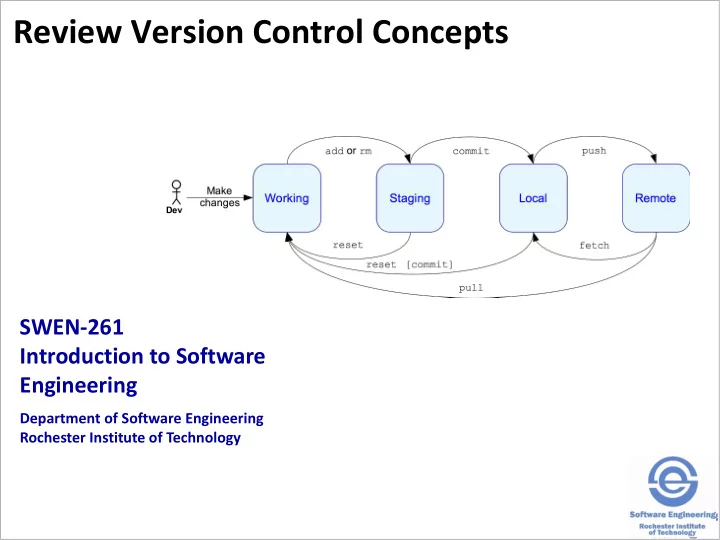

Review Version Control Concepts SWEN-261 Introduction to Software Engineering Department of Software Engineering Rochester Institute of Technology
Managing change is a constant aspect of software development. The Product and Sprint backlogs represent the upcoming changes. A software release is a snapshot of code at a certain time. • Capturing a certain set of user stories • Multiple releases may be done so the team needs to keep track of multiple snapshots (aka versions) Version control systems (VCS) are used to manage changes made to software and tag releases. 2
There are a few fundamental activities of change management that every VCS supports. Directories and files are tracked in a repository . • Each developer has their own workspace. • But share a common remote repository. You can • Make changes in your workspace Add files or directories Remove files or directories Modify or move files Binary files are tracked as a single unit • Commit the changes to a repository. • Sync your workspace with a repository. • Create branches to track user stories. • Explore the history and changes to a repository. 3
Git has four distinct areas that your work progresses through. This is your local working This is your local copy of the shared directory where you do your remote repository which may not be development work. in sync with the remote. Working Staging Local Remote These are the changes that you This is the shared remote specified you want in your next repository that you use to commit to the local repository. synchronize your work with the rest of the team's work. 4
Your local repository and working copy do not automatically stay in sync with the remote. A merge incorporates new A fetch synchronizes the changes fetched to the local local repository with the repository into the current branch remote repository. that your working copy is on. merge fetch Working Local Remote pull fetch merge A branch is an independent A merge may detect changes that can stream of repository changes not be automatically incorporated. which isolates work from the This is called a merge conflict. rest of the repository. 5
When you make local changes, those changes must pass through all four areas. You add to the staging area all of your working copy changes that you want to commit. Finally, you push the changes to the remote repository. Works commit push add Working Staging Local Remote on files Then you commit those changes to your local copy of the repository. The default behavior for git will not allow you to push to the remote repository if your local repository is not up-to-date with remote. Getting in sync may create merge conflicts with your local changes that you will have to fix. 6
Version control branching supports the ability to manage software releases. At the end of a sprint, the team will want to include done stories but exclude incomplete stories. This cannot be done when all of the stories are developed in the master branch. Feature branching is a technique that creates a branch for each story during development. • Changes are isolated in specific branches. • When the story is done, the feature branch is merged into the master branch. • The master branch never receives incomplete work. • Thus master is always the most up-to-date, working increment. 7
An example sprint at the end. Sprint 2 Sprint 1 Ready Sprint 2 In Dev In Test Done Done for Test Backlog S8 (5) S3 S1 S4 S2 S6 S5 8
The life cycle of the feature branch is tied to the development cycle of the user story. 9
Two developers collaborate on a story by working on the same feature branch. The developers share code on a story by syncing to the same remote feature branch. 10
Two interdependent stories can share changes across two branches. The first story branch is created from master and the second branch is created from the first. Not shown are the coordinating remote branches 11
Merging happens a lot and usually goes well; other times not so much . Every time you sync with the remote repository a merge occurs. A merge conflict occurs when there is at least one file with overlapping changes that can not be automatically resolved. 12
Here's an example of a merge conflict. Consider Betty and Sam independently fix this bug. /** * Calculate a half-off discount. */ public float calculateDiscount(final float cost) { return cost * 2; } Betty did this: return cost / 2; Sam did this: return cost * 0.5f; When Sam merges in the code from Betty: ➔ git merge dev1 Auto-merging src/main/java/com/example/model/Promotion.java CONFLICT (content): Merge conflict in src/main/java/com/example/model/Promotion.java Automatic merge failed; fix conflicts and then commit the result. 13
Resolving a simple text conflict is often easy. When a conflict occurs git reports the affected files. public float calculateDiscount( final float cost) { <<<<<<< HEAD The HEAD in Sam's workspace. return cost * 0.5f; ======= return cost / 2; This is the code from Betty's branch. >>>>>>> dev1 } Determine the best solution, and remove the other solution and the marker text. Then follow through with an add, commit, and push. 14
To minimize the number of times when conflicts will not resolve easily, follow several guidelines. 1. Keep code lines short; break up long calculations. 2. Keep commits small and focused. 3. Minimize stray edits. 4. If multiple developers are collaborating on a feature, each developer should sync with the remote feature branch regularly. Merge in the remote feature branch and then push to it, if you have changes. 5. If development of a feature is taking a long time, back merge master to sync completed features for this sprint into the feature branch. 15
Using feature branches will be a standard part of your development workflow. 16
Recommend
More recommend